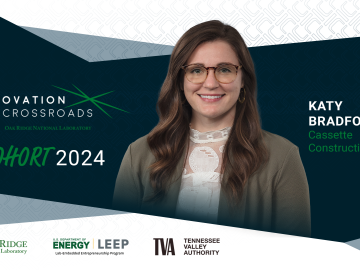
Filter News
Area of Research
- Advanced Manufacturing (2)
- Biological Systems (1)
- Biology and Environment (33)
- Clean Energy (114)
- Computational Biology (2)
- Computational Engineering (2)
- Computer Science (4)
- Electricity and Smart Grid (3)
- Energy Sciences (1)
- Functional Materials for Energy (2)
- Fusion and Fission (9)
- Fusion Energy (1)
- Isotope Development and Production (1)
- Isotopes (29)
- Materials (59)
- Materials for Computing (7)
- Mathematics (1)
- National Security (27)
- Neutron Science (22)
- Nuclear Science and Technology (9)
- Quantum information Science (2)
- Sensors and Controls (1)
- Supercomputing (62)
News Topics
- (-) Biomedical (61)
- (-) Cybersecurity (35)
- (-) Energy Storage (112)
- (-) Frontier (45)
- (-) Grid (66)
- (-) Isotopes (57)
- (-) Mathematics (9)
- (-) Partnerships (51)
- (-) Space Exploration (25)
- 3-D Printing/Advanced Manufacturing (128)
- Advanced Reactors (34)
- Artificial Intelligence (100)
- Big Data (60)
- Bioenergy (92)
- Biology (101)
- Biotechnology (24)
- Buildings (65)
- Chemical Sciences (73)
- Clean Water (31)
- Climate Change (105)
- Composites (30)
- Computer Science (198)
- Coronavirus (46)
- Critical Materials (29)
- Decarbonization (85)
- Education (4)
- Element Discovery (1)
- Emergency (2)
- Environment (200)
- Exascale Computing (42)
- Fossil Energy (6)
- Fusion (58)
- High-Performance Computing (93)
- Hydropower (11)
- Irradiation (3)
- ITER (7)
- Machine Learning (50)
- Materials (147)
- Materials Science (146)
- Mercury (12)
- Microelectronics (4)
- Microscopy (51)
- Molten Salt (9)
- Nanotechnology (60)
- National Security (72)
- Net Zero (14)
- Neutron Science (137)
- Nuclear Energy (111)
- Physics (64)
- Polymers (33)
- Quantum Computing (37)
- Quantum Science (72)
- Renewable Energy (2)
- Security (25)
- Simulation (51)
- Software (1)
- Statistics (3)
- Summit (59)
- Sustainable Energy (130)
- Transformational Challenge Reactor (7)
- Transportation (98)
Media Contacts

Katy Bradford is on a mission to revolutionize the construction industry and is the founder of Cassette Construction, a company in the newest cohort of Innovation Crossroads, a DOE Lab-Embedded Entrepreneurship Program node at ORNL. As an Innovation Crossroads fellow, Bradford and her company will receive technical, financial and networking support to successfully advance the company’s products to the marketplace.
After retiring from Y-12, Scott Abston joined the Isotope Science and Engineering Directorate to support isotope production and work with his former manager. He now leads a team maintaining critical equipment for medical and space applications. Abston finds fulfillment in mentoring his team and is pleased with his decision to continue working.

As a mechanical engineer in building envelope materials research at ORNL, Bryan Maldonado sees opportunities to apply his scientific expertise virtually everywhere he goes, from coast to coast. As an expert in understanding how complex systems operate, he’s using machine learning methods to control the process and ultimately optimize performance.

Nuclear physicists at the Department of Energy’s Oak Ridge National Laboratory recently used Frontier, the world’s most powerful supercomputer, to calculate the magnetic properties of calcium-48’s atomic nucleus.
Researchers at ORNL recently demonstrated an automated drone-inspection technology at EPB of Chattanooga that will allow utilities to more quickly and easily check remote power lines for malfunctions, catching problems before outages occur.

To speed the arrival of the next-generation solid-state batteries that will power electric vehicles and other technologies, scientists led by ORNL advanced the development of flexible, durable sheets of electrolytes. They used a polymer to create a strong yet springy thin film that binds electrolytic particles and at least doubles energy storage.

Jeremiah Sewell leads a team at ORNL, working on xenon-129 production for lung imaging. Reflecting on his career, Sewell views each opportunity as a "door" he steps through, leveraging over 25 years of experience in nuclear power and centrifuge operations to advance the facility’s mission.

At ORNL, a group of scientists used neutron scattering techniques to investigate a relatively new functional material called a Weyl semimetal. These Weyl fermions move very quickly in a material and can carry electrical charge at room temperature. Scientists think that Weyl semimetals, if used in future electronics, could allow electricity to flow more efficiently and enable more energy-efficient computers and other electronic devices.

In an impressive showcase of cutting-edge innovation and scientific prowess, ORNL has been recognized as a beacon of technological excellence, receiving 14 R&D 100 Awards, announced this week by R&D World magazine.

Benjamin Manard, an analytical chemist in the Chemical Sciences Division of the Department of Energy’s Oak Ridge National Laboratory, will receive the 2024 Lester W. Strock Award from the Society of Applied Spectroscopy.


